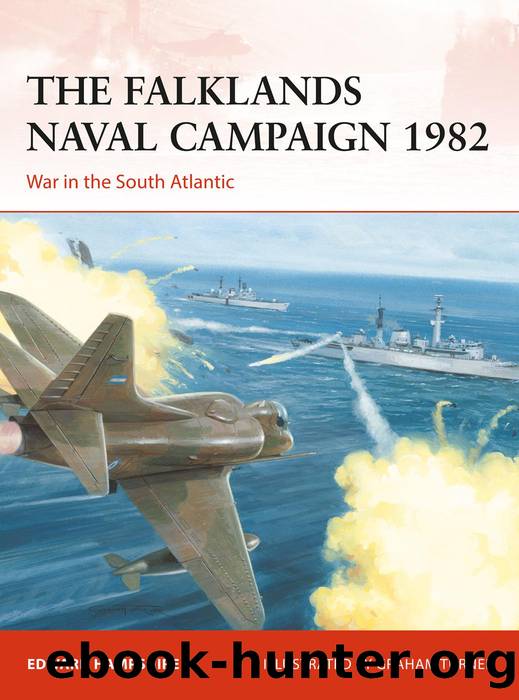The Falklands Naval Campaign 1982: War in the South Atlantic by Edward Hampshire & Graham Turner

Author:Edward Hampshire & Graham Turner
Language: eng
Format: epub
Publisher: Bloomsbury Publishing Plc
Published: 2020-11-17T00:00:00+00:00
The troopship Canberra and the frigate Andromeda at San Carlos at the end of the conflict. During the landings, Canberra carried 42 Commando and was nicknamed the âGreat White Whaleâ. Despite her size, she was hit by Argentine aircraft. (Ken Griffiths, Public Domain)
Once the first waveâs objectives had been reached, the second wave, consisting of 45 Commando and 3 PARA, then embarked on the LCVPs and LCUs. The objective of 3 PARA was Port San Carlos â the northern finger of San Carlos Water area â whilst 45 Commandoâs was Ajax Bay on the western side of San Carlos Water, opposite San Carlos settlement. Neither of these landings was heavily opposed, and in fact some elements of the supporting third wave arrived at their objectives before the second wave, with RFA Sir Percivale arriving at Ajax Bay before the first boats of 45 Commando had reached the shore. At Port San Carlos, the half company of Argentine infantry had not stirred at any of the British activity, only reacting when the British landing craft approached the beach in front of Port San Carlos. They rapidly retreated into the interior, only lightly engaging with the advancing Paras. As morning arrived, the British were firmly in control of a bridgehead stretching from Fanning Head to the Sussex Mountains.
The Argentine garrison at Goose Green had not appreciated what was occurring to the north, but was well aware of the SAS action, as well as a diversionary shore bombardment by the frigate Ardent, firing over 20,000m from Falkland Sound from 0723hrs onwards. Goose Green Airfield sent up two Pucaras to investigate the origin of the shore bombardment; Ardent was spotted but not the landing force, and one of the Pucaras was shot down by a ground-launched Stinger missile fired by the SAS after the pair had been thwarted in an attempted attack on the frigate. A second pair of Pucaras was sent up, this time to investigate reports of British helicopters to the north and attack a suspected fire control position for shore bombardment. These two were intercepted by the Harrier CAP, and one of the Pucaras was strafed by the Harriersâ 30mm cannon and destroyed. A GR3 Harrier attack on the Argentine helicopter base at Mount Kent, destroying two helicopters and damaging one more, limited the Argentine ability to respond with air-mobile troops. So far, the Argentines had still not fully grasped that the main British landing had occurred: Goose Green was aware of Ardent and some increased helicopter activity, whilst the retreating Argentine land forces had not properly communicated with the armyâs command in Stanley. However, the known presence of Ardent was sufficient for an order to go out for an air attack on that frigate. Four flights of Daggers took off from the mainland between 0945hrs and 1000hrs.
Meanwhile, a reconnaissance flight of two Aermacchi MB339 light jets from Stanley Airport was ordered. One of the aircraft suffered a malfunction and could not take off, so Lieutenant Owen Crippa took off alone at 1004hrs flying north-west in order to approach Falkland Sound from its north entrance.
Download
This site does not store any files on its server. We only index and link to content provided by other sites. Please contact the content providers to delete copyright contents if any and email us, we'll remove relevant links or contents immediately.
| Africa | Americas |
| Arctic & Antarctica | Asia |
| Australia & Oceania | Europe |
| Middle East | Russia |
| United States | World |
| Ancient Civilizations | Military |
| Historical Study & Educational Resources |
Machine Learning at Scale with H2O by Gregory Keys | David Whiting(4184)
Never by Ken Follett(3794)
Fairy Tale by Stephen King(3220)
The Man Who Died Twice by Richard Osman(2997)
Oathbringer (The Stormlight Archive, Book 3) by Brandon Sanderson(2886)
Will by Will Smith(2793)
Rationality by Steven Pinker(2291)
The Dark Hours by Michael Connelly(2245)
Can't Hurt Me: Master Your Mind and Defy the Odds - Clean Edition by David Goggins(2228)
The Dawn of Everything: A New History of Humanity by David Graeber & David Wengrow(2122)
Friends, Lovers, and the Big Terrible Thing by Matthew Perry(2119)
Principles for Dealing With the Changing World Order: Why Nations Succeed and Fail by Ray Dalio(1974)
HBR's 10 Must Reads 2022 by Harvard Business Review(1777)
A Short History of War by Jeremy Black(1762)
Go Tell the Bees That I Am Gone by Diana Gabaldon(1687)
515945210 by Unknown(1599)
A Game of Thrones (The Illustrated Edition) by George R. R. Martin(1589)
Kingdom of Ash by Maas Sarah J(1527)
443319537 by Unknown(1470)
